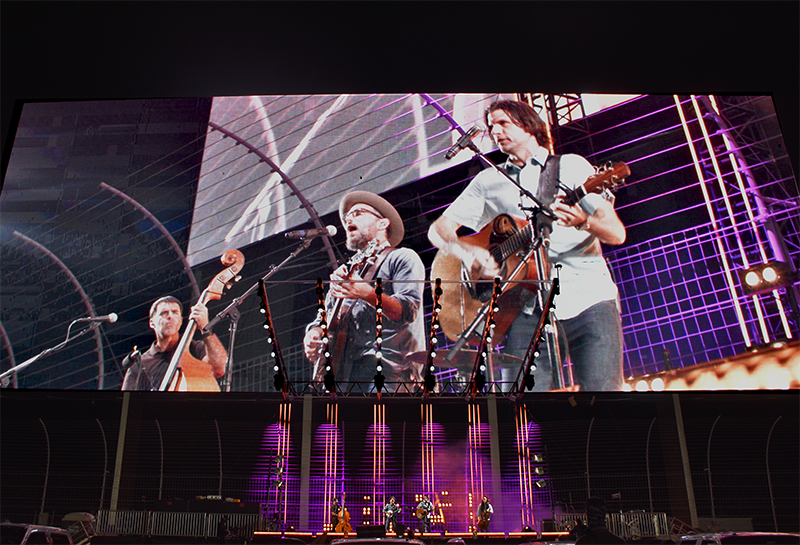
Innovative thinking on how to continue putting on shows in the live entertainment business while under the veil of the Covid-19 pandemic has resulted in a remarkable outdoor roof structure known as the Pterodactyl. Designed by Jim Brammer, CEO of Special Event Services, the impetus for the stage and roof came when the Avett Brothers band manager Dolphus Ramseur called on Adam Paul, CEO of 7 Cinematics about doing an outdoor live event that would be live-streamed simultaneously.
“I suggested we do something big,” recalls Paul. Ramseur and Paul had collaborated on a similar effort years before, when the Avett brothers played a three-night, sold-out run of shows at Red Rocks Amphitheatre near Denver. The final night was live streamed back to North Carolina on the newly installed LED screen at Charlotte Motor Speedway. Completed in 2011, a Guinness World Record was set with its debut as the world’s largest HDTV at a sports venue, spanning nearly 16,000 square feet of viewing pleasure for fans.
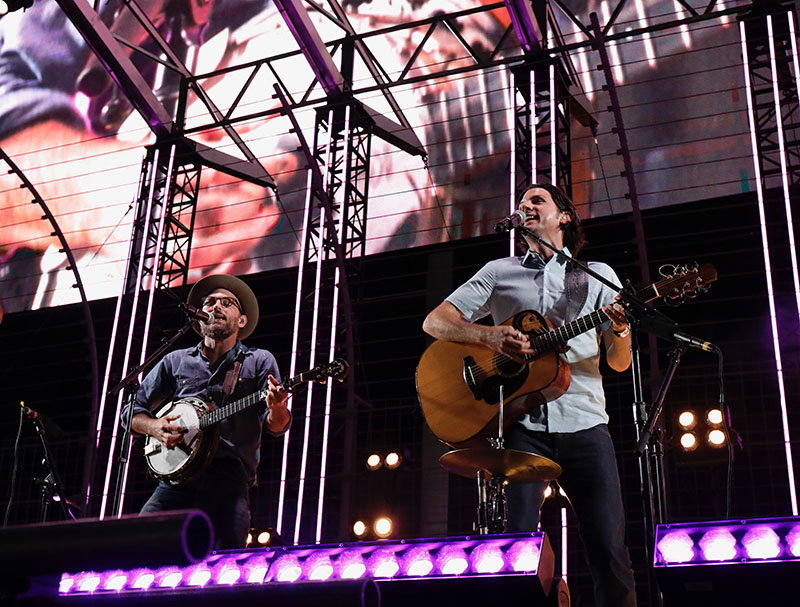
Ramseur works with a longtime friend and consultant Adrian Parker. It was Parker who suggested the Charlotte Motor Speedway; Parker has had close ties with the race track through his years as a marketing PR for
NASCAR. “Things just began to fall into place,” says Ramseur, of the support team that surrounds the Avett Brothers family.
Jim Brammer, along with SES co-founder, Jeff Cranfill, have been the lighting, audio, and staging vendors for the Avett Brothers since their inception. Brammer has taken on more of an oversight role with SES, shifting his focus to G2 structures. And what a focus it has been.
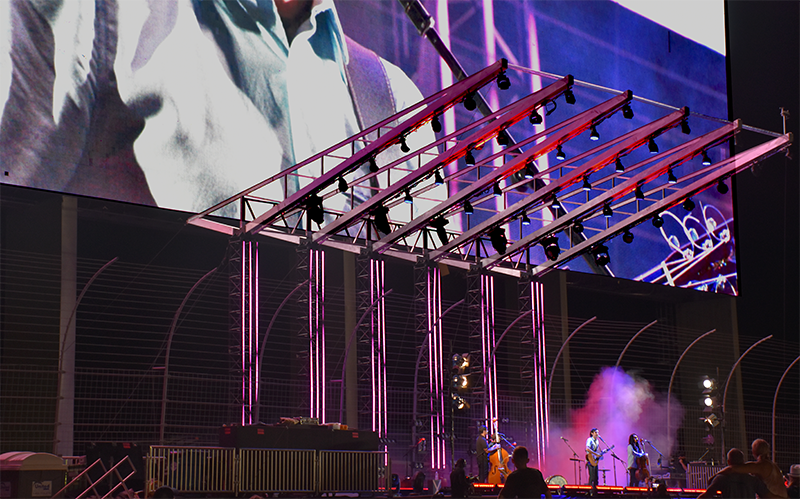
The Pterodactyl
The idea of putting on a show on the infield of the legendary racetrack they all went to since they were kids had a special appeal. “I jumped on the idea,” says Brammer. “Our company success is intimately intertwined with the Avett Brothers. We are all longtime friends who all grew up in this part of North Carolina and are huge NASCAR fans.
“My first thought was that the roof had to be transparent,” adds Brammer. “This way, people nearest to the stage could still get the full impact of the LED screen backdrop.” The result was a series of six cantilevered overhead beams. Made of lightweight, high-strength aircraft aluminum, each beam sat in a custom steel cradle atop the G2 proprietary K2i tower. The beams raked at a trim from 30 feet upstage to 45 feet downstage. G2’s patented K2i trussing on ballast plate bases support the upright towers to which the cantilevered beams are attached. The lighting for the show was attached underneath the cantilevered arms before it was craned into place.
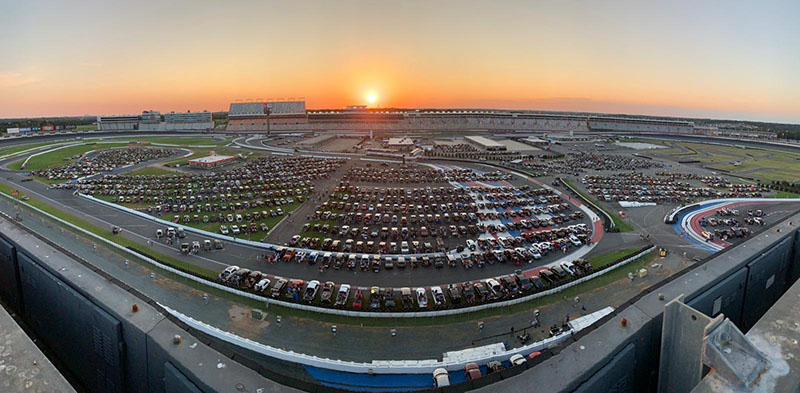
Taking into account that the producer wanted the massive 220-by-80 foot (WxH) LED screen as a backdrop, along with the fact that the furthest viewing point from the stage was almost 2,000 feet, he wanted to design a stage that did not obstruct the imagery in any way. Brammer and his team created the Pterodactyl Structure. “We also wanted to create as intimate of an environment as possible, so it did not feel like the fans were watching a movie, and we wanted the Avett Brothers to get that immediate feedback from the audience,” says Brammer.
Working with a skeleton crew of 12 due to the furloughs that had taken place because of the pandemic shutdown, most the roof and stage were built out of existing inventory and erected at the G2 Structures facility in North Carolina. Rated as able to withstand winds of up to 40 miles an hour, it stood for two weeks and received the Clark Reder Structural Engineering stamp of approval.
This is not a self-climbing roof. “We install the structure using a crane,” Brammer adds, a concept that has become somewhat standard since Stageco introduced the concept to the States in the early 1990’s. On the day of the show at sound check, with great weather ahead, it was determined to completely remove the transparent skins, providing an even better viewing experience for the fans and enhancing the industrial look overall.
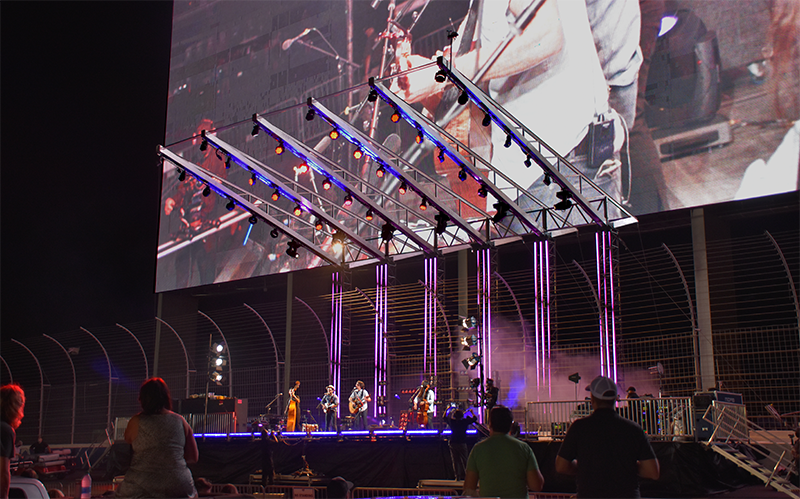
Lighting
SES’ Jeff Cranfill designed the lighting for the show. His first thought, when told of the project, was simply “Perfect.” He and the band’s lighting designer, Pete Schroth, have forged a professional and personal friendship over the last 11 years. The Covid pandemic had forced Schroth to take a day job, since the band is not touring, so he very much handed the reins over to SES, design-wise. “And they knocked it out of the park,” Schroth says. “Jeff knows so well how I run a show that I felt totally at ease with him designing this, considering I couldn’t devote the proper time to site surveys, design and previz.”
Schroth programmed the looks for the show using Cranfill’s fixture choices for his brushstrokes. “My big challenge was, ‘How do I make people that are sitting in their cars get drawn into the show, replicate the experience of a packed crowd?’” He did this with broader sweeping audience looks, more than usual. “We weren’t trying to reinvent an Avett Brothers show experience, but we did have to adjust to these particular environment and broadcast purposes.” The act is usually intimately lit, with band members occasionally left in subdued light.
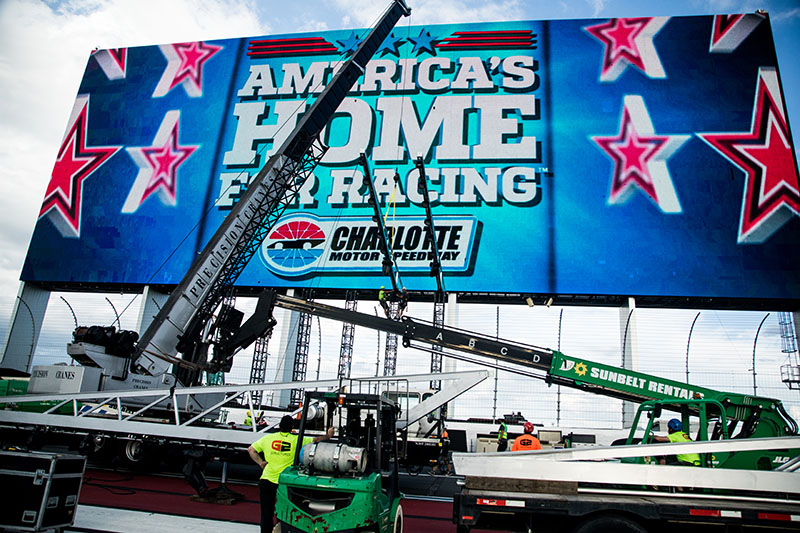
Overall, he feels the success of the event happened because everyone was happy to be working again. The guys at the track were phenomenal, too. “I was amazed at how smoothly they navigated the placement of 1,500 cars in the infield. But mostly, I think the fans are responsible for the success of this. They wanted to get back to seeing live music and did everything we asked to ensure it was done in a safe and orderly way.”
A genuine concern that plagued Schroth and led to a few sleepless nights was the need to get this event absolutely right. “It just seemed like the few attempts before, this got torn apart by the media. I wasn’t at these events, so I can’t say, but it seemed like everyone was coming at our industry from all sides. You know, holy smokes, are we ever going to get to work again?” But he knew he couldn’t stay down that rabbit hole and moved on to do “what we all love about this business.”
Says Cranfill, “We’re truly from North Carolina, and the Avett Brothers grew up just down the street. Just anything that involves NASCAR is a huge charge for us, especially doing a show at some place as immaculate as Charlotte Motor Speedway.”
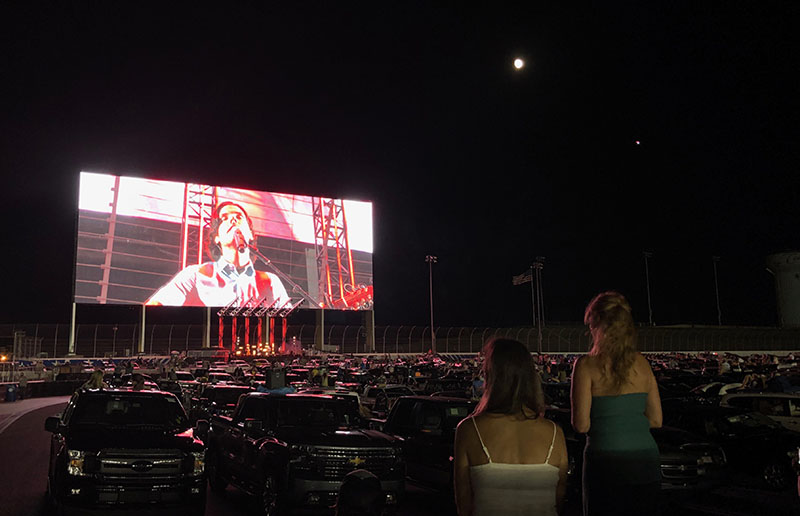
The idea of staging the show on the infield started with pondering how to use the 200-by-80-foot LED wall as a visual centerpiece. From there, designs started to flow, and it was obvious the look had to be clean and clear. During the first sight survey, as Cranfill was looking at the heavy wire rope fence, he knew immediately that it had to be lit to be included in the industrial look the Pterodactyl roof already presented.
“We wanted to celebrate where we were at,” says Cranfill. “Usually, I would try to mask something like that in ordinary circumstances, with a valance or scenic backdrop for the bottom of the screen. We threw light all over the fence behind the band as they played. I mean, here we are, literally standing on a stage on the track by the retaining wall of fence that some hero of ours going 200 miles an hour scraped up against. And this let the stream viewers dive into where we were at, too.”
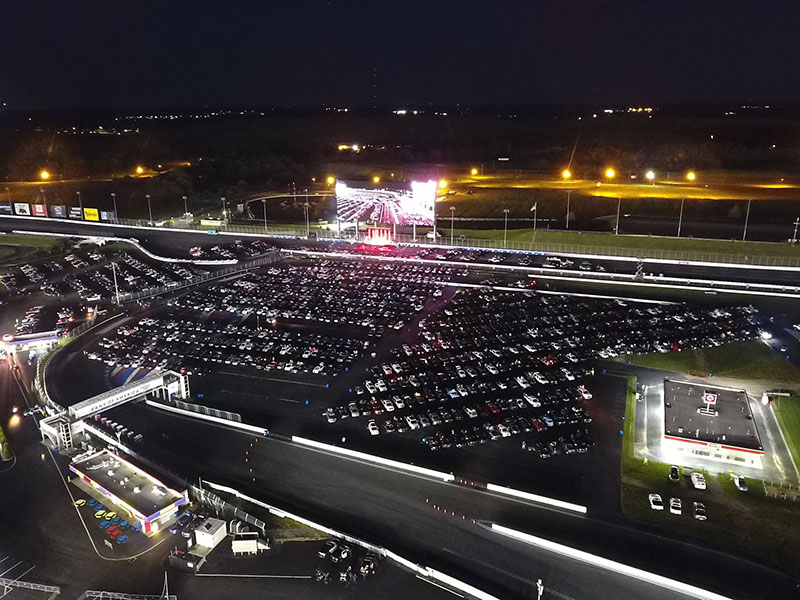
The biggest challenge was to create a design that was unobtrusive, but still captured the stage and band at the right color temperature for the cameras. It had to be open and clear to let everyone from the front to the back row feel that they were at a concert, not watching a movie. That melded with Brammer’s concept of getting the Pterodactyls high enough, so they were actually in the viewing area of the screen.
“Whether you’re several hundred feet or a thousand feet back, this way, you still saw the stage,” says Cranfill. “You still saw the structure of the stage; you still saw the lighting. Our design prioritized bringing everyone into the concert. Of course, the closer you got to the stage, the experience kept evolving. By the time you got to the front row, most of those people had a really clear view of the band, but it was still really cool to look up through the structure of the roof and see the LED wall. Everything — the LED wall, the fence, the Pterodactyl roof — all became one giant industrial set.”
The racetrack lighting, which came from what would be considered the back of the house, was turned on to create a bit of glow for the infield. This made just enough of a shadowy silhouette so the band standing on that stage could look out through that expansive infield and see an ocean of cars — more than 1,500 of them.
Cranfill was also aware he needed to get the streaming audience at home to feel like they are a part of a live event. “When the camera drones captured shots from behind the wall, even through the fence, the audience never lost the feel they were outdoors at a venue with a live band on stage.”
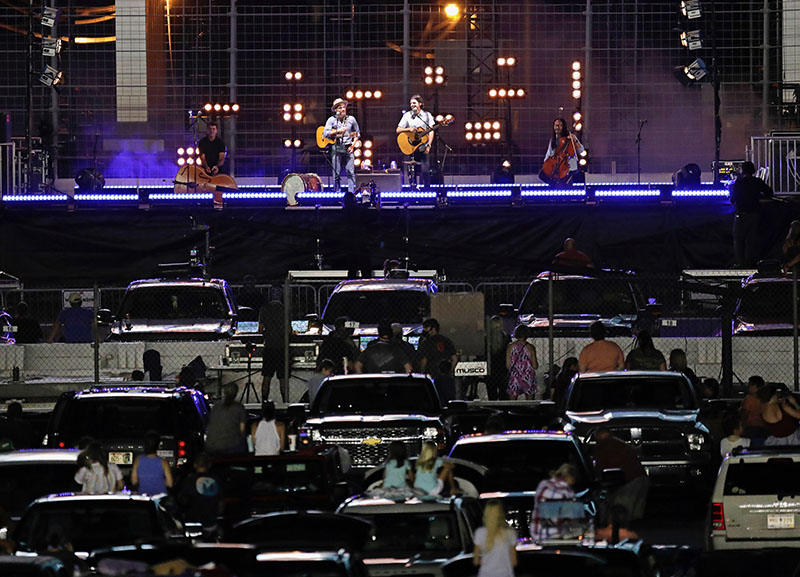
Cranfill used a lot of lighting fixtures normally called for by LD Schroth. “But we also brought in a few extra pieces and parts just to make sure we had good key lighting for cameras. The show started right at sunset, so there were a few minute color temperature changes. All the lighting was balanced for video with that in mind, which made it easy to give Adam in the truck a nice warm glow for camera shots. We were able to establish some shots from way in the back showing the cars. I thought it just made for a really exciting look.” More fixtures lining the downstage edge, and up the Pterodactyls, meanwhile, helped establish the architecture the band was playing in.
“We are just starting to figure out how to do these drive-in concerts, which I think we did successfully. We’re all still on Cloud 9 about it, but hey, when its you’re one big show of the year, you really get excited.”
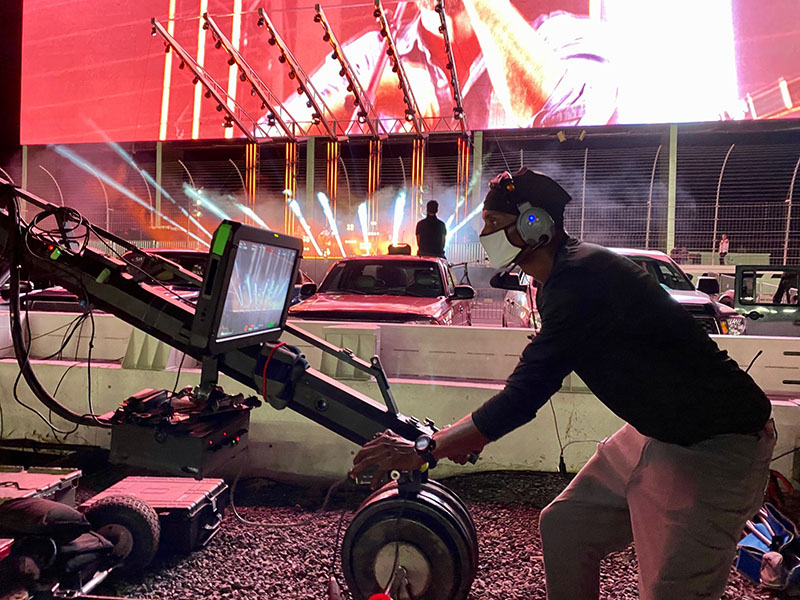
Streaming Video
“Jeff and Pete designed a cool show tailored to the way the set was designed and the camera streaming,” says Adam Paul of 7 Cinematics. “They executed a flawless show. It was not a huge lighting rig. They kept it less imposing for the purpose of preserving that Avett Brothers intimacy. And the unique roof structure Jim designed, while huge, perfectly preserved and enhanced that intimate vibe.”
Paul then tells PLSN, “Our job was to put imagery onto the LED screen there and do a live stream as well. We were responsible for all the video production side of the show. We try to stay very much in our lane. We don’t do walls; we just do the pure cinematic productions.”
The video company provided the base stream of the 4K 2398, to Nugs.net for their pay-per-view. Nugs.net then down samples it on their server side to offer a 4K and a 1080 Pay Per View (PPV) stream. The signal was encoded in Nugs’ studio and in the 7 Cinematics truck.
As Paul notes, 7 Cinematics own trucks that have a unique design. “They are more of a flypack-style truck/grip truck/cinema truck rather than a true sports broadcast truck,” says Paul. Camera jibs were used high and wide. Four drones, two up and two down, proved indispensable in capturing a lot of the action, particularly the drive around the track as the band rode toward the stage.
“Our biggest challenge was that we cut the show from under the screen,” Paul continues. “The broadcast booth was a was literally a quarter mile as the crow flies, and then we had to bounce it back. It wasn’t like we were in a theater where it’s a hundred feet from the stage box to where you’re cutting. We had to go in through the fiber optic and patch everything. It all goes to the booth and then back to the screen. The internet had to be patched from the booth and back to us through fiber so we could then send it out. The logistics were complicated, though I find those type of challenges fun. I enjoy figuring those pathways out and working through those puzzles.”
Timelines are always a challenge for a live event. “This was reasonably sensible,” says Paul, “so I had a big massive runway to land on. It took about three weeks, which gave us plenty of time to really think through and visit the site, get really acclimated and accustomed with the place. The parts that we love as production geeks are working through the problems and having a deadline to get them done. Imagine, A deadline again!”

From Lockdown to Showtime
By the time of the event, the 7 Cinematics crew was fairly consistent in getting tested regularly. “We had all been tested within the last two weeks, says Paul. “I was doing temperature tests on site too, as were all the other departments. Everyone went through all the protocol, all wore masks and practiced social distancing, and it worked. The only time masks were off was, obviously, when the band was on stage. When I started to call the show, I asked everyone to leave the truck because I had to have my mask off to clearly communicate.”
Paul continues, “We’ve all been cooped up, scared, and nervous a bit.” He then proceeds to tick off the markers that have been missing during the pandemic: “The deadlines, the collaboration with the teams, there’s a crowd coming in. All these pieces that make a live event what it is. It was exciting for me personally, and my team. This was not a ‘me’ thing at all. It was a team effort, through and through and through. From everybody’s side. I think we did it for us, but not in a selfish way — it was a healing thing. We did it for the fans, which is the most important thing. We did it for the whole industry.
“As video people, we are not touring people,” Paul continues. “We jump in on the big productions, kind of in the middle of things. More often than not, the touring crews are a little rode hard, put up wet by the time we get to them, and a little grouchy. We’re in their way, affecting their space. But on this show, everyone was just so happy to be working.”
The event was self-promoted by Ramseur and his team. “I must say, I have never worked as hard on a show as I have on this performance. We wanted everybody to be safe, above all else. We’re just in different times. This is not something we usually do, but I have an old saying, ‘Don’t worry if the horse is blind, just load the wagon.’” Ramseur’s wife had another take on the proceedings as she lived through this with him. “She said to me, ‘Not only were we building a plane, but we were learning to fly it at the same time.’
“In the throes of this pandemic,” Ramseur continues, “looking at all our options, this was the best place that we could choose that could be safe for our fans, our crews, the band, the Speedway staff. We are lucky that we live mere miles away from the speedway that has one of the largest TV screens in the world. Having great fans who heard us when we let them know we need them to work with us enabled us to pull it all together without something backfiring.”
Ramseur thinks he probably fielded close to a thousand emails and knows Parker had over 1,200 emails for this one show. “We put a lot of heart and soul into it and it was a special night. It showed a little bit of glimmer of hope. Above all, though, it was a great night for the music industry to show that if you work with the fans and the venue and they work with you, these events can be pulled off safely.”
Adds Cranfill, “Not only did we build a plane and fly it, but we landed it safely.”
The Avett Brothers at Charlotte Motor Speedway
Aug. 29, 2020
SES/G2 Design and Management Team:
- Jim Brammer
- Jeff Cranfill
- Jason Farah
- Michael Brammer
- Greg Hareld
SES Crew:
- David Stover
- Andrew Steelman
- Travis Reasoner
- Dave Cheek
- Michael Tate
- Will Hatley
- Chip Fishcesser
- Justin Duguid
- Josh Cox
- Joey Cockerham
G2 Crew:
- Cliff Ward
- Lawrence Lightner
- Adam Ellis
- Kaitlin Ellis
- Chet Puda
- Matt Rapp
- Rodney Christopher
- Montana Dean
SET Drivers:
- Jerry Martin
- Ronnie Brown
Avett Brothers Crew:
- Pete Schroth – Lighting Director
- Adam Coomes – Tech
- Tom Lasky – Tech
- Chris Collins – Monitor Engineer
- Justin Glanville – FOH Engineer (FM)
- Walker Terrell – Production Manager
- Dane Honeycutt – Tour Manger
- Jay Shamblin – Security
- Jason Richmond – Stream Mix
The Avett Brothers:
- Scott Avett
- Seth Avett
- Bob Crawford
- Joe Kwon
Avett Brothers Management: (Ramseur Records)
- Dolphus Ramseur
- Adrian Parker
7 Cinematics Gear and Crew:
- Blackmagic Ursa Mini G2
- RED KOMODO Storm Troopers
- Zeiss and Canon Cinema Glass
- Blackmagic 4K Flypack
- Ford Transit Hybrid Production Truck (Mobile Cinema Unit)
- DJI 6K drone
- 32ft Jib
7 Cinematics camera support:
- Adam Paul (Director) CEO of 7C
- Adrian Westendorff (producer / Cam op) VP of 7C
- Ben Walter (producer / Cam op) VP of 7C
- Mark Zenow (A&R)
- Keith Blackard (producer / Cam op)
- Gripp Richardson (Jib Op)
- Jake Butler (Steadi-Cam Op)
- Taylor Hawkins (Cam Op)
- Hunter Sykes (Production Assistant)
- Shane Watson EIC
SES Lighting Gear:
- (30) GLP X4
- (6) Martin Aura XB
- (6) Martin Air FX
- (10) Clay Paky Mythos 2
- (24) Elation Chorus Line 16
- (3) Thomas 8 Lite
- (4) Thomas 4 lite
- (5) Thomas 4 lite vertical
- (5) Thomas 2 lite
- (6) Arri 2K JR Fresnel
- (108) Martin VDO Sceptron 10
- (2) Grand MA 2 full-size consoles
- (2) Grand MA NPU
- (2) MDG Fogger
- (2) MDG Atmosphere Hazer
More info on companies supporting this event can be found at www.specialeventservices.com, www.g2structures.com, www.7cinematics.com and www.ramseurrecords.com.


